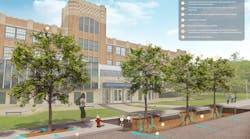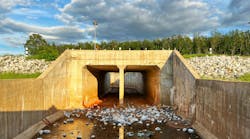Webinar Q&A: Combining green and gray infrastructure for stormwater management and flood risk reduction
In February, Stormwater Solutions hosted the “Combining Green and Gray Infrastructure for Stormwater Management and Flood Risk Reduction,” webinar featuring Mark Van Auken, stormwater and green infrastructure practice leader for Arcadis, and Joel Kaatz, stormwater resilience and flood risk management discipline lead, also for Arcadis.
The benefits of green infrastructure for water quality and runoff volume reduction are well known, but potential benefits for flood risk reduction is an emerging opportunity and consideration. Green infrastructure can be an effective tool in reducing peaks from significant rainfall events, but the efficacy is dependent on the size of the event, design goals of the practice(s), and the target level of service, often requiring combination with traditional gray infrastructure to help mitigate major weather events like hurricanes. This webinar provided case studies of planning, design and construction projects that feature holistic runoff reduction solutions using combinations of green and gray infrastructure practices that reduce flooding and provide community amenities.
The webinar is now available to view on-demand here, and below, you will find responses to some of the questions from the Q&A.
Audience: What methodologies are being implemented to calculated the coincidence of surge and SLR conditions?
Van Auken & Kaatz: This is an area of ongoing research in the academic and consulting community. Typically, a statistical assessment is conducted on historic still water elevations in co-occurrence with rainfall rates to determine if the two variables should be considered independent or not. In practice, we often choose a wide range of joint-probability events to assess the impacts of hydrologic and hydraulic models. The model results are then used to inform stakeholders of the risk and guide appropriate interventions and acceptable risk levels.
Audience: Does the tool capture physical parameters or how is integrated in the city wide plan?
Van Auken & Kaatz: The GI Siting Tool does capture physical parameters such as soil type, drainage area, etc. The results shown in the Master Plan are static and based on agreed upon criteria weighting but the tool itself is dynamic in its application and can be modified when used to assess an individual site or project area.
Audience: What is your opinion/experience on the assurance of effectiveness of green infrastructure within the private properties?
Van Auken & Kaatz: Having the requirement of independent verification of performance on a regular (annual) basis has proven effective, though it can be a little costly to the property owner. It generally puts the burden on the landowner and reduces workload and costs for the community.
Audience: Can you further explain the planning considerations for projects of a watershed scale approach? Large grey/green solutions at the bottom/shoreline of the watershed to address large volumes of water may not be the best option. Identifying the various areas where runoff builds and combines with other buildup areas to further exacerbate volumes at the bottom of the watershed need to be considered and addressed.
Van Auken & Kaatz: When looking at the use of green and gray on a watershed scale it is beneficial to consider widespread use of both. For example, we were involved in the Dutch Dialogues in Charleston, South Carolina, a few years ago. We found use of GI in the center (high point) of the downtown peninsula to reduce runoff volume paired with gray in the spine and along the coast to be the most effective option. In the project example discussed, the gray was required at the downstream end due to the significant cost that would be required to implement large-scale green in the dense urban area capable of managing extreme weather events.
Audience: Is "rray water" referring to exclusively combined sewer overflow or including reclaimed water (treated wastewater)?
Van Auken & Kaatz: Gray water can refer to both combined sewer (sanitary and stormwater) as well as reclaimed water.
Audience: Have underground rock bed storage systems been used in your projects? Are they considered green or grey?
Van Auken & Kaatz: We have designed underground rock bed storage but almost exclusively for storage after stormwater is filtered - so in our applications it has been green.


